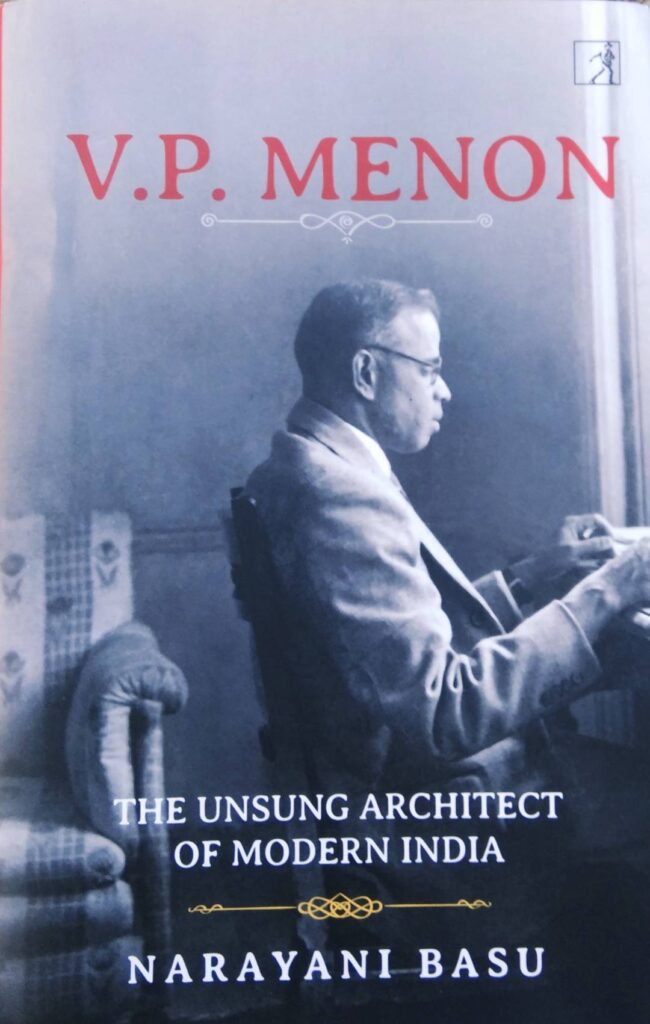Bhaskar Parichha

In 1947, as the struggle for India’s freedom, was intensifying, the Indian National Congress and the Government of India had a single objective—to politically integrate the country. To accomplish this, the Department of State was established in June 1947 with two important men at the helm of affairs. One was the fearless leader who also became the first Deputy Prime Minister of India—Sardar Vallabhbhai Patel. Yet, the person who continued to remain unsung was Patel’s right-hand man, VP Menon.
Although it was Patel who created the original framework to influence the Indian princes to accede, it was Menon who did the actual groundwork of coaxing them. He traveled from court to court, state to state having numerous eye-to-eye discussions and negotiations. While his wit and diplomacy were able to win over several of the erstwhile maharajas, the task was arduous. It is said Menon once had a close shave with death when an angered maharaja sprung out a gun and threatened to shoot him point-blank.
When he was young, Ottapalam- born Menon on one occasion overheard his father, lamenting the lack of resources, and his inability to give his six children the life they deserved. Moved by his father’s struggle to make both ends meet, the young boy who was just a matriculate, decided to trade education for a string of menial jobs. He left his home in search of a job, intending to shoulder the financial responsibility of the big family and help his father. From being a construction worker to a coal miner, factory hand to an unsuccessful cotton broker —he did it all.Menon’s adventures and experiences are narrated in his own book: ‘The Story of the Integration of the Indian States. This book is considered to be one of the most comprehensive works on the political integration of India on the eve of independence.
The present book ‘VP Menon -The Unsung Architect of Modern India’ ( Simon & Schuster) by Narayani Basu – she happens to be Menon’s great-granddaughter – throws further light on the man who changed the map of the Indian subcontinent – and the world – forever. Besides being a historian and foreign policy analyst, Basu writes extensively on foreign policy for international journals, while remaining involved in her core discipline — modern Indian history. The book is the result of her devotion and authenticity.
Drawing from documents — scattered, unread and un-researched so far — and with first-time access to Menon’s papers and his taped confidential and frank interviews — this the biography covers the life of this public figure, his unconventional personal life and his private conflicts, which are said to have made him feed his energy into public service.
Says the blurb, ‘with his initial plans for an independent India in tatters, the desperate viceroy, Lord Mountbatten, turned to his senior most Indian civil servant, Vappala Pangunni Menon—or VP—giving him a single night to devise an alternative, coherent and workable plan for independence. Menon met his stringent deadline, presenting the Menon Plan, which would change the map of the world forever.’
Menon was unarguably the architect of the modern Indian state. Yet, surprisingly little was known about this bureaucrat, patriot and visionary. Basu ‘rectifies this travesty’ in every respect. She takes us through the highs and lows of VP’s career, from his determination to give women the right to vote; to his strategy to get the princely states to accede to India; to his decision to join forces with the Swatantra Party; to his final relegation to relative obscurity.
Merging the 554 princely states with the Indian state was one of the most structurally monumental tasks that the Indian administration faced after Independence. Menon worked closely with Sardar Patel to help amalgamate these princely states with India.
Writes Basu, ‘Mountbatten’s original plan envisaged not the cleavage of the Indian subcontinent into two countries, but its vivisection into over a dozen. Each province would have the right to secede; each princely state would have the right to become independent if it so chose. Confronted by Nehru’s incandescent rage at the prospect of fragmentation, conflict, and disorder, Mountbatten had had no choice but to call in his constitutional advisor. Menon typed up his alternative plan in the room of his modest guesthouse, in six hours flat…’
As Political Reforms Commissioner, Menon was in a unique position to witness the way the three Viceroys under whom he served – Linlithgow, Wavell, and Mountbatten – went about dismantling their cherished possession. Basu deals with the ‘different ways’ in which the Viceroys interacted to either delay or finally hastily precipitate the inevitable that led to Partition.
Divided into five painstaking sections and sixty chapters, this 450-page book has some brilliant narrative. Basu tells about how during Menon’s first stint at the Round Table negotiations in London in 1930, the Prince of Sarila advised him never to be afraid of looking straight into the eyes of the British administrators who were in command and of speaking his mind. He also learned the importance of dressing impeccably.
Says Basu in the epilogue, ‘in real life, he was a man in the peculiar position of standing at the very forefront of history, but shadowed by the political giants of the day. Only when he spoke to Harry Hodson in 1965, that he gave free rein to his tongue allowing memories, long held to himself, to finally break free.’
A persuasive and enthralling biography on an able statesman by an equally competent historian!
‘VP Menon -The Unsung Architect of Modern India’
Narayani Basu
Simon & Schuster India
818, Indraprakash building
21, Barakhamba Road
New Delhi 110001





























